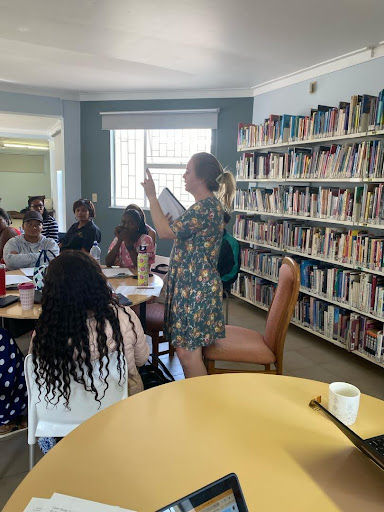Spotlight on a lesson by our instructional coach at WIS
- Windhoek International School
- Nov 24, 2023
- 3 min read
Dear WIS Community,
You might be familiar with Mr. Derrek Berkompas, our instructional coach, who became a part of the WIS community in August. We are delighted to have Mr. Derrek with us! Below is a spotlight on his role and his practice at WIS.

What does an instructional coach do?
An instructional coach serves as a catalyst for professional growth and excellence. The role is aimed at enhancing teaching practice and fostering a culture of continuous improvement. Teaching is complex, and working alongside an instructional coach can help teachers navigate this complexity by providing modelled lessons, targeted feedback, enhancing their instructional practices and positively impacting student learning outcomes.
How complex teaching and learning is, is captured in our WIS Principles to Practice, which provides us with the language to talk about what good teaching and learning looks like.
This week I was lucky to see Derrek teach a lesson in 5B, and observed many of the teaching moves outlined in our WIS Principles to Practice. As teachers we make many intentional decisions and to the blind eye it may not seem obvious why they are happening. In this article, I will make these decisions explicit by unpacking Derrek’s instructional moves.
THE LESSON
The aim of the lesson was to get students to think about different methods for fractions.

Movement
Derrek got the children up on their feet in two rows at the start of the lesson and at regular intervals throughout the lesson.
Intention: Incorporating movement into learning benefits fifth graders by enhancing cognitive function, increasing engagement, and improving concentration. Physical activities stimulate brain function, making lessons more enjoyable and maintaining students' interest. Movement also fosters social and emotional development, providing stress reduction and supporting a positive classroom environment.
Growth Mindset
He then showed students a trick with a gyro ring and asked a couple of children to have a go. It was hard and only one could master it the first time. He talked about the term F.A.I.L meaning First Attempt In Learning.
Intention: Starting a lesson with a focus on growth mindset is crucial because it sets a positive tone for learning. By emphasising the idea that abilities can be developed through dedication and effort, students are more likely to embrace challenges and view mistakes as opportunities for learning.
Engagement Strategies
Derrek used many engagement strategies throughout the lesson in order to keep students’ attention with him at all times: ‘show me a thumbs up/ thumbs down if you heard me’, ‘I’m waiting for eye contact’, ‘turn and talk about what you think this means’, ‘watch my non-verbal cues’.
Intention: These strategies create an interactive and participatory environment, promoting student engagement, understanding, and collaboration, which are essential elements for effective learning. They also are known as formative assessment strategies- a teacher needs to constantly gauge whether students are grasping the content.
Learning Intentions
WALT= We Are Learning Today. Derrek asked students to write WALT on their paper.
Intention: Sharing learning intentions (WALT) is effective instruction because it provides clarity on what students are meant to learn. It helps students focus on key concepts, encourages metacognition and reflection, and allows for differentiation to meet individual learning needs. The transparent communication of learning goals also facilitates effective feedback and ensures alignment between teaching and assessment.
Multiple exposures
In Derrek’s Maths lesson, students were engaged in a range of opportunities to engage with fractions and decimals, from choral counting of decimals (read out as fractions), engaging them as inquirers (what pattern do you see?) folding a paper into fractions (manipulatives) and showing students four different fraction methods (equivalent fraction method, multiplication method, box method and area method).
Intention: Multiple exposures provide students with multiple opportunities to encounter, engage with, and elaborate on new knowledge and skills.

Checking for understanding: Exit tickets
If you think that just by explaining content to students, they will learn, think again. A teacher always needs to check whether learning took place by collecting evidence of understanding. This is also how they know what to teach next. Derrek used an exit ticket at the end of the lesson and asked students to capture their understanding in two sentences.
Intention: Exit tickets serve as a quick and effective formative assessment tool, allowing teachers to assess student understanding at the end of a lesson. They provide valuable insights for adjusting instruction, offering timely feedback to students and informing teachers about the effectiveness of their teaching strategies. Additionally, exit tickets promote student accountability and help consolidate learning by requiring students to reflect on and apply the key concepts covered in the lesson.

As a community of learners at WIS, we are fortunate to have experts like Derrek work with us to help us with effective teaching and continuous improvement, which reflects our collective dedication to enriching educational experiences for every student at WIS!
Yours in learning,
Marcelle van Leenen
Primary School Principal








Comments